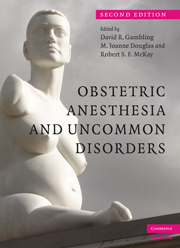Book contents
- Frontmatter
- Contents
- List of plates
- List of contributors
- Preface
- Section 1 Cardiovascular and respiratory disorders
- Section 2 Musculoskeletal disorders
- Section 3 Nervous system disorders
- 9 Disorders of the central nervous system in pregnancy
- 10 Spinal cord disorders
- 11 Peripheral neuropathy
- 12 Chronic pain in pregnancy
- Section 4 Metabolic disorders
- Section 5 Other disorders
- Index
- Plate Section
- References
12 - Chronic pain in pregnancy
from Section 3 - Nervous system disorders
Published online by Cambridge University Press: 19 October 2009
- Frontmatter
- Contents
- List of plates
- List of contributors
- Preface
- Section 1 Cardiovascular and respiratory disorders
- Section 2 Musculoskeletal disorders
- Section 3 Nervous system disorders
- 9 Disorders of the central nervous system in pregnancy
- 10 Spinal cord disorders
- 11 Peripheral neuropathy
- 12 Chronic pain in pregnancy
- Section 4 Metabolic disorders
- Section 5 Other disorders
- Index
- Plate Section
- References
Summary
Introduction
Pain is defined as a sensory and emotional experience associated with actual tissue damage or described in terms of such damage. This definition has endured through time; however, the classification of the different types of pain is evolving. Original descriptions of pain were based on a temporal evolution, where the distinction between acute and chronic pain was that if it lasted for more than six months it was considered chronic. Another more conservative and innovative view proposed one month as the defining criterion. These early definitions did not account for the mechanisms involved in the development of the pain. The prevailing contemporary view is to classify pain according to the primary pathology involved in the cause of pain, namely: inflammatory (acute) or neuropathic (chronic). The latter can be considered a disease of the nervous system and not merely a symptom of some other condition. Furthermore, poorly treated acute pain can lead to neuropathic chronic pain. The current temporal cutoff value for chronic pain is three months.
During pregnancy, acute inflammatory pain, usually arising from labor and delivery, is the most common type of pain. However, other pain syndromes (chronic neuropathic or acute inflammatory evolving to chronic neuropathic) have been recognized throughout pregnancy. In this chapter we will discuss painful entities encountered during pregnancy, focusing on the chronic pain states and recurrent inflammatory pain that may lead to chronic pain.
- Type
- Chapter
- Information
- Obstetric Anesthesia and Uncommon Disorders , pp. 229 - 238Publisher: Cambridge University PressPrint publication year: 2008



